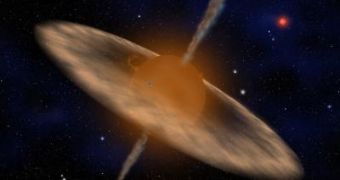The concept of brown dwarfs is somewhat cloudy to astronomers, and it describes a planet not large enough to be a star, although it shares some characteristics, it seems. Scientists from the Harvard-Smithsonian Center for Astrophysics (CfA) located in Cambridge, Massachusetts, have managed to accomplish a task they thought impossible given the modern technology, namely to detect the way such a brown dwarf planet is formed.
The data provided by the Smithsonian's Submillimeter Array (SMA) allowed them to depict carbon monoxide molecules ejecting from two diametrically opposed sides of an object known as ISO-Oph 102. This phenomenon is regularly associated with the birth of stars and their early years, but the object in question is no such thing. It only bears an estimated mass 60 times that of Jupiter, which is way under the minimum (75 Jupiters) that experts calculated to be necessary for a star to support nuclear fusion.
So, the astronomers categorized it as a brown dwarf, a type of planet with a mass usually comprising 15 to 75 Jupiter masses, usually referred to as failed stars. Recent observations indicated that the features it shows might link its formation process rather to that of stars than that of planets. Stars form as a result of a gaseous cloud's collapsing under its own gravity, while planets are born out of a protoplanetary disk of debris. The star accelerates its spinning as it keeps collapsing and releases the CO bipolar jets in order to shed its angular momentum.
The flow rate and mass content of the ISO-Oph 102 brown dwarf are, as expected, 100 and 1,000 times respectively less than those of an actual star. "These findings suggest that brown dwarfs and stars aren't different because they formed in different ways," explained Paul Ho, an astronomer from the Harvard-Smithsonian Center for Astrophysics and the director of Academia Sinica Institute of Astronomy and Astrophysics, quoted by Eurekalert. "They share the same formation mechanism. Whether an object ends up as a brown dwarf or star apparently depends only on the amount of available material."

 14 DAY TRIAL //
14 DAY TRIAL //